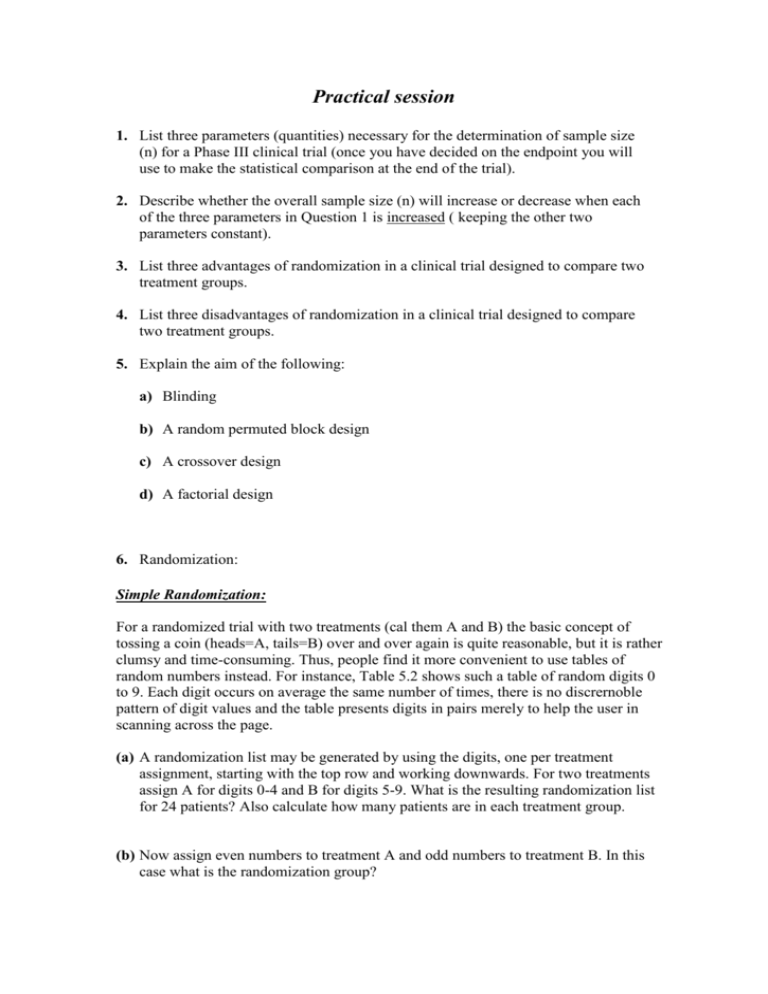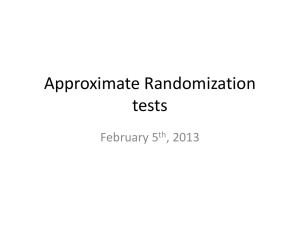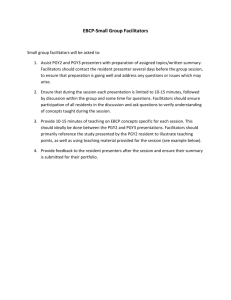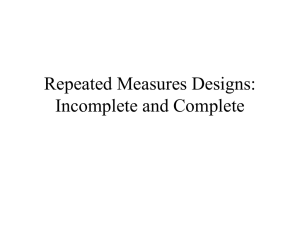Stratum I: Age < 50 and 1 – 3 +ve nodes
advertisement

Practical session 1. List three parameters (quantities) necessary for the determination of sample size (n) for a Phase III clinical trial (once you have decided on the endpoint you will use to make the statistical comparison at the end of the trial). 2. Describe whether the overall sample size (n) will increase or decrease when each of the three parameters in Question 1 is increased ( keeping the other two parameters constant). 3. List three advantages of randomization in a clinical trial designed to compare two treatment groups. 4. List three disadvantages of randomization in a clinical trial designed to compare two treatment groups. 5. Explain the aim of the following: a) Blinding b) A random permuted block design c) A crossover design d) A factorial design 6. Randomization: Simple Randomization: For a randomized trial with two treatments (cal them A and B) the basic concept of tossing a coin (heads=A, tails=B) over and over again is quite reasonable, but it is rather clumsy and time-consuming. Thus, people find it more convenient to use tables of random numbers instead. For instance, Table 5.2 shows such a table of random digits 0 to 9. Each digit occurs on average the same number of times, there is no discrernoble pattern of digit values and the table presents digits in pairs merely to help the user in scanning across the page. (a) A randomization list may be generated by using the digits, one per treatment assignment, starting with the top row and working downwards. For two treatments assign A for digits 0-4 and B for digits 5-9. What is the resulting randomization list for 24 patients? Also calculate how many patients are in each treatment group. (b) Now assign even numbers to treatment A and odd numbers to treatment B. In this case what is the randomization group? The advantage of such a simple method is that each treatment assignment is completely unpredictable and probability theory guarantees that in the long run the numbers of patients on each treatment will not be radically different. However, clinical trials are of finite size and one should consider the possibility that the treatment numbers may end up unequal. For instance, above in the first case we ended up with 10 patients in A and 14 in B which is somewhat inconvenient and inefficient. There is also the possibility to end up with 8 in one group and 16 in the other. Only in large trials, say with 200 patients does the chance of severe imbalance become so remote that simple randomization may be recommended, but a problem could still arise if one intends to analyse early results while the trial is in progress. Random Permuted Blocks: A more convenient method of restricted randomization is to ensure exactly equal treatment numbers at certain equally spaced points in the sequence of patients’ assignments. Suppose we have T treatments, then for each block of say kT patients we produce a different random ordering of k assignments to each treatment. Firstly, for blocks of relatively small size one can use a table of random numbers as in Table 5.2 to produce the randomization list. (c) For two treatments, blocks of two patients assign AB for digits 0 – 4 and BA for digits 5 – 9. Construct the randomization list for 24 patients and start from the last row (4 8 3 …). The smaller the choice of block size the greater is the risk of randomization becoming predictable so that one should particularly avoid a block size of two. (d) This time consider a block of four patients and two treatments so we have 6 combinations. Assign AABB for 1, ABAB for 2, ABBA for 3, BBAA for 4, BABA for 5, BAAB for 6 and ignore 0 and 7 – 9. Again for 24 patients but start from the 6th row (7 3 6 …). The Biased Coin Method: Even though the above ‘blocking’ is widely accepted one should consider whether such strict equality is necessary. One really needs to avoid major inequalities in treatment numbers and Efron (1971) has proposed the biased coin method, which is as follows for the two-treatment case. At each point in the trial one observes which treatment has the least patients so far: that treatment is then assigned with probability p > ½ to the next patient. If the two treatments have equal numbers then simple randomization is used for the next patient. The common values for are the following 3/4, 2/3, 3/5, or 5/9. Hence, p= 3/4 maintains very strict control on treatment numbers but a consequence is somewhat predictable once any inequality exists. p = 2/3 may be an appropriate choice for a relatively small trial whereas p = 3/5 is satisfactory for larger trials of say 100 patients. The randomization list for such a method can be generated using Table 5.2 as follows: For p = 3/5 assign the treatment with least patients for digits 0 –5 the treatment with most patients for digits 6 – 9 When treatment numbers are equal assign A for digits 0 – 4 B for digits 5 – 9 Using the first row again from Table 5.2 we get: 0 A 7 A 5 A 5 B 4 B 1 A 2 A 1 B 5 B 7 A 6 B 6 B 8 A 8 B 9 B 4 B 3 A 6 B 3 B 8 B etc… The bold indicates those points where treatment numbers were equal and simple randomization was used. (e) How would you assign the treatments with p = 2/3 ? Stratified Randomization: Stratified randomization is like an insurance policy in that its primary aim is to guard against the unlikely event of the treatment groups ending up with some major difference in patient characteristics. The first issue is to decide which patient factors one should stratify by. Random Permuted Blocks within Strata: We will consider a breast cancer example, where chemotherapy L-Palm (A) is to be compared with placebo (B). There were two patients factors considered to be of major prognostic importance: nodal status (i.e. the number of positive axillary nodes) and age. As regards the former, one expects a poorer prognosis for patients with a larger number of positive nodes. The importance of age is not only that older patients tend to have shorter survival, a fact not directly due to disease, but that the potential benefits of adjuvant chemotherapy such as L-Palm may depend on the patients’ age. After choosing the relevant factors, the next step is to categorize each one into two or more levels. Accordingly age was split into under or over 50 while nodal status was split into 1 – 3 or 4 positive nodes. The choice of split is inevitably somewhat arbitrary but should take into account the numbers of patients likely to be in each category. Also, in this case age 50 provides an approximate division into pre- and postmenopausal. So we have 2 x 2 = 4 strata, the following: Stratum I: Age < 50 and 1 – 3 +ve nodes Stratum II: Age 50 and 1 – 3 +ve nodes Stratum III:Age < 50 and 4 +ve nodes Stratum IV:Age 50 and 4 +ve nodes Then before the trial begins a separate restricted randomization list is prepared for each of the patient strata using the method of permuted blocks described before. (f) Consider that Stratum I has 8 patients, Stratum II has 10 patients, Stratum III has 12 patients and Stratum IV has 14 patients. Use Table 5.2 to get the randomization lists for Stratum I start from row 10, for Stratum II start from row 13, for Stratum III start from column 6 and for Stratum IV start from column 18. To remind you AABB: 1 ABAB: 2 ABBA: 3 BBAA: 4 BABA: 5 BAAB: 6 ignore 0, 7-9




